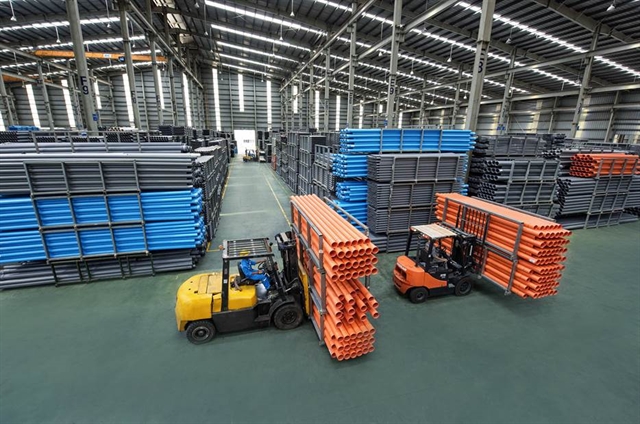 Economy
Economy


|
| Inside a Hoa Sen Group factory. — Photo courtesy of the group |
HÀ NỘI — The COVID-19 pandemic has hit Vietnamese enterprises in a wide range of industries but many of them have found ways to effectively mitigate the pandemic’s impact on their business, maintain production and ensure the growth of revenues and profits.
In the steel sector, several enterprises such as Hoa Sen Group (HSG) survived the COVID storm thanks to their export markets.
HSG reported revenue and after-tax profit of VNĐ4.7 trillion (over US$200 million) and VNĐ320 billion ($13.7 million) in August, representing 66 and 47 per cent year-on-year increases, respectively. The figures were reported by Người Lao Động (Labourer) newspaper, citing the group’s consolidated business results sent to the State Securities Commission and the Hồ Chí Minh Stock Exchange on September 27.
In 11 months of the fiscal year 2020-21, HSG estimated its total production output at over two million tonnes, far exceeding its initial plan of 1.8 million tonnes and surging 43 per cent year-on-year.
The group’s revenue in the reviewed period reached over VNĐ42.5 trillion, nearly double that of the same period in the prior financial year, while its profit after tax reached an estimated VNĐ4 trillion compared to VNĐ1 trillion seen in the same period.
The newspaper quoted a representative of HSG as saying that export was one of the group’s two main sales channels as its products were being shipped to over 87 countries and territories. Amid the global outbreak of the COVID-19 pandemic, HSG's export volume still grew strongly.
Data from the Việt Nam Steel Association showed that in the first half of 2021, the group’s galvanised steel export volume accounted for more than 42 per cent of the whole industry's galvanised steel exports. It had signed contracts to export over 120,000 tonnes of this product each month until the end of November.
A deep-water seaport located at its factory, which enabled the group to ship steel products to overseas markets, helped HSG gain a competitive edge in exports.
In August alone, HSG produced 681,000 tonnes of crude steel, up 40 per cent over the same period of last year, while its sales volume of steel products reached 690,000 tonnes.
In the field of confectionery, KIDO is among enterprises that are promptly changing development goals and branching into new businesses in order to turn disaster into opportunity and better meet the needs of local customers.
Amid the social distancing period, KIDO has focused on researching activities to churn out new and unique products which are different to those of other enterprises in the industry. Besides ice cream, milk tea, tea and coffee, branded Chuk Chuk, the firm is also offering other products such as green mango juice with chili salt and red guava juice.
Meanwhile, many enterprises in the wood industry have made great efforts to implement the "3 on-site" model to ensure the supply chain and fulfil export orders. That has contributed to $11.14 billion export turnover the industry gained in the nine-month period, up 31 per cent over the same period last year.
The firms have also modern technologies and equipment to partly meet the needs of automation, reducing the pressure on labourers, enjoying opportunities to seek new customers, according to Ngô Sỹ Hoài, vice chairman of the Việt Nam Timber and Forest Products Association.
Most businesses in the industry have provided vaccinations for their workers, and they expected that a "safe and flexible adaptation and effective control of the COVID-19 pandemic" strategic policy would create opportunities for the whole sector to resume production and meet increasing export orders in the last months of the year, Hoài added.
The wood industry was striving to reap about $16 billion from exports by the end of this year, much higher than $12.3 billion seen in 2020, according to the association.
Similarly, fruit and vegetable exporters brought home nearly $2.75 billion from January-September, up 10.4 per cent year-on-year, said the Việt Nam Fruit and Vegetable Association.
In September alone, their exports were estimated at over $232 million, up 1.52 per cent over the previous month as goods circulation improved, leading to a slight increase in export value, General Secretary of the association Đặng Phúc Nguyên told the newspaper.
Demand from overseas markets such as China, Japan Russia, the US and Australia, which increased between 23 per cent and 46 per cent, also helped the industry's export picture improve, Nguyên said. — VNS




